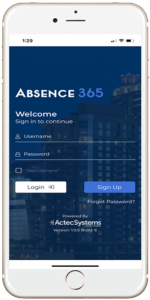 If employees are suffering from burnout, they’re more likely to make mistakes, experience drops in productivity, or start to have attendance problems (i.e. arriving late, leaving early, or calling out of work). Even if only one or two employees are struggling with burnout, managers are likely to notice the effects are office-wide. Once one employee stops pulling his or her weight, other employees have to pick up the slack. This puts added stress on the rest of the staff and can cause a chain reaction of burned out employees. Even if burned out employees don’t affect their coworkers, they are prone to making costly errors that can cause delays.
If employees are suffering from burnout, they’re more likely to make mistakes, experience drops in productivity, or start to have attendance problems (i.e. arriving late, leaving early, or calling out of work). Even if only one or two employees are struggling with burnout, managers are likely to notice the effects are office-wide. Once one employee stops pulling his or her weight, other employees have to pick up the slack. This puts added stress on the rest of the staff and can cause a chain reaction of burned out employees. Even if burned out employees don’t affect their coworkers, they are prone to making costly errors that can cause delays.
Thankfully, employee burnout is easy to spot. If managers and employers pay attention to their employees, they can recognize key indicators of burnout and take steps to rectify it before it begins hurting productivity and company morale through employee absenteeism and presenteeism.
- Heightened cynicism. Once productive employees may begin to balk at requests. A sudden shift to pessimism indicates the employee is disillusioned with or frustrated by his or her work. On that note, if an employee who is known for being a go-getter becomes negative and doubtful of certain objectives or goals, he or she may be experiencing burnout.
- Mistakes increase in frequency and severity. Seeing more typos when employees are under tight deadlines isn’t surprising. However, when an employee who often performs perfect work begins to make preposterous mistakes, something is wrong. The employee may feel underappreciated or overworked. Employers need to take the time to determine if the mistakes are the result of the employee growing careless or if he or she is suffering from burnout.
- Sudden disinterest with work. If a certain employee who always has ideas or contributes to the conversation goes silent at every meeting, he or she may be suffering from burnout. If the employee is overburdened with work, he or she isn’t going to engage any further until the problem is rectified.
- Attendance problems emerge. Some employees struggle with attendance, but when a previously punctual employee starts coming in late, leaving early, or not showing up at all, something is not right. Absent employees can derail projects, hurt productivity, and torpedo workplace morale. Managers must leverage absence reporting tools to determine if the sudden attendance problems are the result of family issues, an illness, or excessive work. If the problem is the latter, burnout is the culprit behind the absences.
Preventing burnout before it can take hold among the staff is of vital importance to businesses. If your company is trying to contend with absenteeism, Actec can help. Our absence reporting program can improve productivity, reduce absenteeism, and simplify your attendance keeping processes. Contact us to learn more.

 Building an effective employee schedule is critical to every business’s success. This is true whether an organization operates 24/7, works a traditional nine to five, or spans unusual hours. While these companies have different scheduling requirements, all businesses can benefit from the following guidelines when putting together their employee’s schedules:
Building an effective employee schedule is critical to every business’s success. This is true whether an organization operates 24/7, works a traditional nine to five, or spans unusual hours. While these companies have different scheduling requirements, all businesses can benefit from the following guidelines when putting together their employee’s schedules: Working overtime happens in all industries, particularly during peak seasons. However, paying employees overtime is an expense that executives don’t accurately calculate into the budget. It can cause several headaches across multiple areas within the company as well. HR has to make sure the company complies with labor laws as well as field disgruntled employees. Managers have to distribute the additional hours across their teams, which makes scheduling a challenge. Employees that work overtime may harbor resentment toward their employers or burn out from the extra work.
Working overtime happens in all industries, particularly during peak seasons. However, paying employees overtime is an expense that executives don’t accurately calculate into the budget. It can cause several headaches across multiple areas within the company as well. HR has to make sure the company complies with labor laws as well as field disgruntled employees. Managers have to distribute the additional hours across their teams, which makes scheduling a challenge. Employees that work overtime may harbor resentment toward their employers or burn out from the extra work. Considering that call center employees spend their working hours on the phones with customers, opportunities for socializing may seem scant. However, agents aren’t tethered to their seats from the moment they arrive to the instant they clock out of work for the day. Employees visit the breakroom for coffee, take breaks for lunch, or pass each other in the halls.
Considering that call center employees spend their working hours on the phones with customers, opportunities for socializing may seem scant. However, agents aren’t tethered to their seats from the moment they arrive to the instant they clock out of work for the day. Employees visit the breakroom for coffee, take breaks for lunch, or pass each other in the halls. With many employees still telecommuting, businesses are familiar with the challenges of managing employees they no longer see in person. Some of the most common pain points are confusion regarding new procedures or projects, diminished productivity, and administrative difficulties. Businesses can implement several strategies to help reduce these issues.
With many employees still telecommuting, businesses are familiar with the challenges of managing employees they no longer see in person. Some of the most common pain points are confusion regarding new procedures or projects, diminished productivity, and administrative difficulties. Businesses can implement several strategies to help reduce these issues. Many startups and several small businesses often rely on a single individual to manage human resources tasks. Some business owners make this decision due to the small nature of the company and perceived lighter workload. However, even the smallest of businesses have to comply with labor laws and other work regulations.
Many startups and several small businesses often rely on a single individual to manage human resources tasks. Some business owners make this decision due to the small nature of the company and perceived lighter workload. However, even the smallest of businesses have to comply with labor laws and other work regulations. Employee rosters change often, particularly for businesses that experience seasonal rushes. COVID-19 has also changed the makeup of business hours, employee schedules, and more. Having attendance software and procedures in place can help reduce the confusion, boost productivity, and improve profits. Businesses should consider the following to improve scheduling at the employee, management, and business level:
Employee rosters change often, particularly for businesses that experience seasonal rushes. COVID-19 has also changed the makeup of business hours, employee schedules, and more. Having attendance software and procedures in place can help reduce the confusion, boost productivity, and improve profits. Businesses should consider the following to improve scheduling at the employee, management, and business level: Businesses can’t function much less turn a profit if the employees don’t show up to do the work. When absences begin piling up, it has a domino effect on the rest of the company. Projects may fall behind schedule if a key employee is regularly missing. This bleeds into other projects as well as team members may need to stop what they’re doing to catch up on the absent employee’s work. This effects workplace morale as well, causing a company-wide productivity problem.
Businesses can’t function much less turn a profit if the employees don’t show up to do the work. When absences begin piling up, it has a domino effect on the rest of the company. Projects may fall behind schedule if a key employee is regularly missing. This bleeds into other projects as well as team members may need to stop what they’re doing to catch up on the absent employee’s work. This effects workplace morale as well, causing a company-wide productivity problem. Keeping track of employee’s attendance is vital to the success of any business. Attendance is a significant indicator of the overall health of any company. Whether employees are consistently tardy, call out often without notice, or work well after closing time, they can cause a chain of events that derail the company’s goals. For example, employees that have frequent, unplanned absences affect workflow and can delay projects. Conversely, employees that clock 60-hour work weeks on a regular basis run the risk of burnout, which stymies productivity.
Keeping track of employee’s attendance is vital to the success of any business. Attendance is a significant indicator of the overall health of any company. Whether employees are consistently tardy, call out often without notice, or work well after closing time, they can cause a chain of events that derail the company’s goals. For example, employees that have frequent, unplanned absences affect workflow and can delay projects. Conversely, employees that clock 60-hour work weeks on a regular basis run the risk of burnout, which stymies productivity.